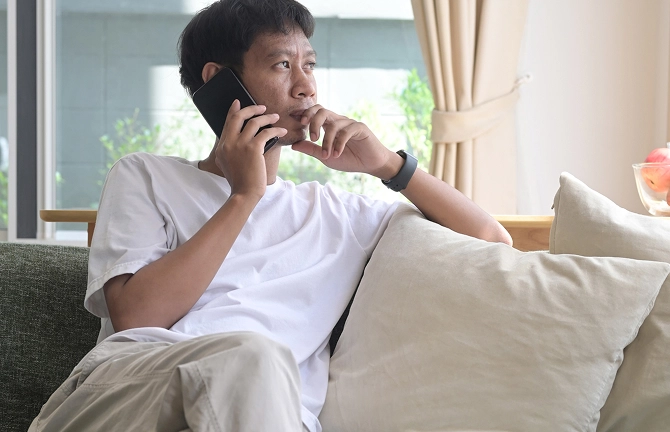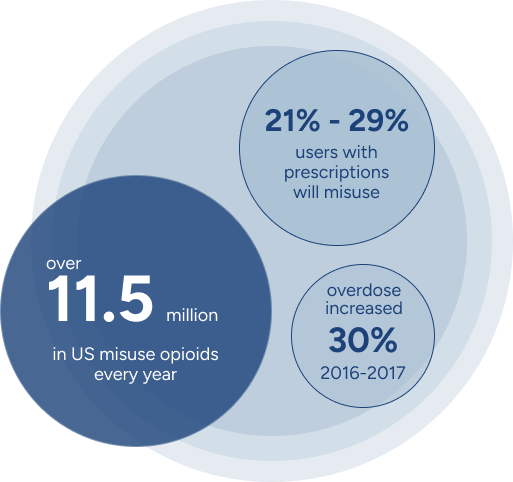Home / Drug & Alcohol Rehab Programs Across New England / Opioid Addiction
Opioid overdose and opioid use disorders are increasingly common in the United States. Across the nation, approximately 130 people die each day due to opioid overdoses. Deaths from opioid overdoses have quadrupled over the past 20 years.
This guide will help you understand what opioids are and how they are different from opiates. You will learn about the different types of opioids and find out how to recognize the signs and symptoms of opioid use disorders and overdose. Information about treatment resources will be provided in the closing section.
Opioids (narcotics) are pain relievers that work by binding to opioid receptors in the brain and spinal cord. They can lessen the intensity of a person’s pain, and they alter how pain is perceived by the brain.
Morphine, the first opioid medication, was created in 1803. Like other early opioids, it was derived directly from opium, a substance that comes from the seed pods of poppies. Today, many newer opioids, including fentanyl, are produced synthetically in laboratories.
Opioids are often prescribed by doctors to treat pain from injuries and chronic health conditions, including cancer. They are frequently administered when patients are recovering from surgery.
After taking an opioid at the recommended dose, people typically feel sleepy, and constipation is a common side effect. Some individuals could develop nausea and vomiting, too. Opioids can cause impairments in judgment and decision-making, and they may cause users to act impulsively.
To reduce the risk of physical dependency, doctors aim to prescribe opioids for the shortest period of time that is needed to treat an individual’s pain. , People are typically given an opioid prescription for no more than three days in cases of acute pain from surgery and injuries.
Individuals with chronic pain may be given opioids for a longer period of time. Doctors will closely monitor them during treatment, and the opioids will generally be prescribed as part of a treatment plan that includes physical therapy, massage, or other treatments that do not use medications.

Technically, the term “opioid” is used to describe any drug that binds to the brain’s opioid receptors. Opioids include both natural drugs derived directly from poppies and synthetic versions that are produced in laboratories. All opiates are part of the opioid family. To be classified as an opiate, an opioid must be extracted from the poppy plant; it cannot be synthetic.

There are three major types of opioids. Each type is classified according to how it is made.
Hydromorphone is used for acute and chronic pain, and it is available in tablet, liquid, and injectable formulations. Hydrocodone is used most often in combination pills that also include non-opioid pain relievers. For example, hydrocodone-acetaminophen is commonly prescribed for the treatment of cancer pain.
Methadone is used to treat chronic pain in people who require 24-hour treatment. It is frequently used to treat people with opioid use disorders as well. Fentanyl is available as a transdermal patch and an oral lozenge, and it can be administered by injection. It can be used for chronic pain in patients who already take other opioids, and it is commonly used to treat breakthrough pain associated with cancer.
Opioid use disorders can cause physical, mental, and behavioral changes. People may feel drowsy, and they could experience weight loss. Flu-like symptoms might occur frequently. Some individuals may have sleep disturbances or changes in sleeping patterns. Decreases in libido could be present.
Mentally and behaviorally, patients with opioid use disorders could be unable to regulate their opioid use due to uncontrollable cravings for opioids. They may continue to use opioids even if they are experiencing worsening depression or other mental side effects. They might also feel that they need more and more of the opioids to achieve euphoria and relieve pain.
When opioid use disorders are present, the individual may withdraw from social activities, isolating themselves from family and friends. There may be new financial difficulties that occur suddenly, and people could repeatedly ask family and friends to borrow money. School and work performance may be negatively impacted, and patients could start having relationship conflicts with family, friends, and co-workers.
People with opioid use disorders could have withdrawal symptoms if they are unable to obtain opioids or if they drastically reduce their dose due to lack of supply. If this happens, family members and friends might notice that the person has mood swings and appears sweaty. Diarrhea could occur as well.

Currently, over 11.5 million people in the United States are believed to misuse opioids every year. In addition, more than 2.1 million individuals are diagnosed with opioid use disorders each year.
An estimated 21% to 29% of patients who are prescribed opioids for chronic pain will end up misusing them. 8% to 12% of these individuals are ultimately diagnosed with opioid use disorders. Roughly 75% of the more than 77,000 annual drug-related deaths in the United States are linked to opioids. Between 2016 and 2017, opioid overdoses increased by 30%.
People who have overdosed on opioids will often have small, constricted pupils that look like pinpoints. Breathing may be very slow and shallow, and the individual might choke or make gurgling noises. The person’s body could be limp, and he or she may fall asleep or lose consciousness. The skin might look pale or blue, and it will generally feel cold to the touch.
If these symptoms occur, an ambulance should be called immediately so that the individual can receive life-saving care. Family members or caregivers can administer naloxone if it is available, and they should aim to keep the person awake and breathing. It can help to lay the individual on his or her side to reduce the risk of choking, and caregivers should stay with the person until paramedics arrive.

To recover from an opioid use disorder, the patient must go through a process known as withdrawal (detox). This rids the body of all of the opioids, and it is the first step in the recovery process. Withdrawal can produce uncomfortable symptoms. Generally, symptoms begin within 24 hours of stopping the opioid, and they can continue for a week or more.
Granite Recovery Centers provides medical detoxification for people who do not need immediate medical intervention, are not a danger to themselves, and are capable of self-evacuation in the event of an emergency.
People could experience medical issues during detox, and many individuals are unable to safely complete detox by themselves. Abdominal cramps, high blood pressure, insomnia, anxiety, sweating, restlessness, and a rapid heartbeat are a few of the symptoms that commonly occur during detox.
Substance use specialists recommend medically supervised detox at a treatment facility to give the patient his or her best chance of a successful recovery. During medically supervised detox, patients are routinely monitored for symptoms. Medications can be administered to ease the discomfort and stress of the detox process so that people have a better chance of completing it.
Treatment centers also provide psychological support and individual therapy sessions to boost the patient’s mental and emotional health during and after detox. They provide structure and time for the patient to explore the reasons behind his or her opioid use disorder. Therapists guide the patient in this task. Most importantly, they help the individual in taking the first steps to rebuild his or her life by healing relationships and discovering a new sense of purpose.
If you have been impacted by an opioid use disorder, it is important to know that you are not alone and that help is available. Your primary care doctor can provide information about local resources that can assist you, and your community health department can offer guidance as well.
People in the New England area may wish to ask their health care professional about attending a residential program at the Green Mountain Treatment Center or the New Freedom Academy. These facilities offer a holistic approach to recovery from opioid use disorders, and they are considered in-network for most major health insurance plans.
Located in Effingham, New Hampshire, the Green Mountain Treatment Center is a secluded retreat that provides medical detox facilities and 24-hour medical monitoring as needed. Clinicians at the center are all trained in addiction medicine. During treatment at Green Mountain, patients follow a 12-step curriculum that is integrated with individual and group psychotherapy sessions.
Green Mountain patients can receive cognitive behavioral therapy, dialectical behavior therapy, and trauma therapy, and each therapy session is tailored to their specific needs. They are also provided with holistic therapy options, including exercise, yoga, and meditation. Gender-separate programs and accommodations are offered, and meals are prepared by a chef.
New Freedom Academy is a 20-bed treatment center that is located on 17 acres of woodland in Canterbury, New Hampshire. This facility specializes in medication-assisted treatment of opioid use disorders, and clinicians are available at all times of the day and night. During their stay at New Freedom Academy, patients have one-on-one therapy sessions, and they can receive treatment for any co-occurring mental conditions that may be present.
New Freedom Academy residents also participate in process groups and motivational interviewing. To help heal the mind and body, residents are encouraged to take part in yoga, meditation, and exercise at the center. These activities help reduce stress and increase endorphins.
Patients at New Freedom are also given access to family recovery workshops to help them strengthen their relationships with their loved ones. These workshops take place each week at an off-site location. As with the Green Mountain Treatment Center, residents at New Freedom Academy are provided with gender-separate living accommodations, and nutritious meals are prepared by a chef.
With help and support, patients and families can recover from opioid use disorders and live in a healthy, positive way.
If you want to visit one of our New England drug rehab centers, please contact us at Granite Recovery Centers. Our experts will work with you to find a high-quality treatment option that meets your needs. We strive to provide a holistic level of treatment with evidence-based care, giving you the help necessary to regain your sobriety for good.

| Cookie | Duration | Description |
|---|---|---|
| __cf_bm | 1 hour | This cookie, set by Cloudflare, is used to support Cloudflare Bot Management. |
| .AspNetCore.Cookies | 11 months | This cookie is installed by BayMark Health Services, Inc. The cookie is used to maintain persistence with ChatGPT sessions. |
| .AspNetCore.CookiesC1 | 11 months | This cookie is installed by BayMark Health Services, Inc. The cookie is used to maintain persistence with ChatGPT sessions. |
| .AspNetCore.CookiesC2 | 11 months | This cookie is installed by BayMark Health Services, Inc. The cookie is used to maintain persistence with ChatGPT sessions. |
| .AspNetCore.CookiesC2 | 11 months | This cookie is installed by BayMark Health Services, Inc. The cookie is used to maintain persistence with ChatGPT sessions. |
| .AspNetCore.CookiesC3 | 11 months | This cookie is installed by BayMark Health Services, Inc. The cookie is used to maintain persistence with ChatGPT sessions. |
| .AspNetCore.CookiesC3 | 11 months | This cookie is installed by BayMark Health Services, Inc. The cookie is used to maintain persistence with ChatGPT sessions. |
| AspNetCore.Cookies | 11 months | This cookie is installed by BayMark Health Services, Inc. The cookie is used to maintain persistence with ChatGPT sessions. |
| AspNetCore.CookiesC1 | 11 months | This cookie is installed by BayMark Health Services, Inc. The cookie is used to maintain persistence with ChatGPT sessions. |
| cookielawinfo-checkbox-advertisement | 1 year | Set by the GDPR Cookie Consent plugin, this cookie records the user consent for the cookies in the "Advertisement" category. |
| cookielawinfo-checkbox-analytics | 11 months | This cookie is set by GDPR Cookie Consent plugin. The cookie is used to store the user consent for the cookies in the category "Analytics". |
| cookielawinfo-checkbox-functional | 11 months | The cookie is set by GDPR cookie consent to record the user consent for the cookies in the category "Functional". |
| cookielawinfo-checkbox-necessary | 11 months | This cookie is set by GDPR Cookie Consent plugin. The cookies is used to store the user consent for the cookies in the category "Necessary". |
| cookielawinfo-checkbox-others | 11 months | This cookie is set by GDPR Cookie Consent plugin. The cookie is used to store the user consent for the cookies in the category "Other. |
| cookielawinfo-checkbox-performance | 11 months | This cookie is set by GDPR Cookie Consent plugin. The cookie is used to store the user consent for the cookies in the category "Performance". |
| CookieLawInfoConsent | 1 year | CookieYes sets this cookie to record the default button state of the corresponding category and the status of CCPA. It works only in coordination with the primary cookie. |
| elementor | never | The website's WordPress theme uses this cookie. It allows the website owner to implement or change the website's content in real-time. |
| viewed_cookie_policy | 11 months | The cookie is set by the GDPR Cookie Consent plugin and is used to store whether or not user has consented to the use of cookies. It does not store any personal data. |
| wpEmojiSettingsSupports | session | WordPress sets this cookie when a user interacts with emojis on a WordPress site. It helps determine if the user's browser can display emojis properly. |
| Cookie | Duration | Description |
|---|---|---|
| yt-player-bandwidth | never | The yt-player-bandwidth cookie is used to store the user's video player preferences and settings, particularly related to bandwidth and streaming quality on YouTube. |
| yt-player-headers-readable | never | The yt-player-headers-readable cookie is used by YouTube to store user preferences related to video playback and interface, enhancing the user's viewing experience. |
| yt-remote-cast-available | session | The yt-remote-cast-available cookie is used to store the user's preferences regarding whether casting is available on their YouTube video player. |
| yt-remote-cast-installed | session | The yt-remote-cast-installed cookie is used to store the user's video player preferences using embedded YouTube video. |
| yt-remote-connected-devices | never | YouTube sets this cookie to store the user's video preferences using embedded YouTube videos. |
| yt-remote-device-id | never | YouTube sets this cookie to store the user's video preferences using embedded YouTube videos. |
| yt-remote-fast-check-period | session | The yt-remote-fast-check-period cookie is used by YouTube to store the user's video player preferences for embedded YouTube videos. |
| yt-remote-session-app | session | The yt-remote-session-app cookie is used by YouTube to store user preferences and information about the interface of the embedded YouTube video player. |
| yt-remote-session-name | session | The yt-remote-session-name cookie is used by YouTube to store the user's video player preferences using embedded YouTube video. |
| ytidb::LAST_RESULT_ENTRY_KEY | never | The cookie ytidb::LAST_RESULT_ENTRY_KEY is used by YouTube to store the last search result entry that was clicked by the user. This information is used to improve the user experience by providing more relevant search results in the future. |
| Cookie | Duration | Description |
|---|---|---|
| _uetsid | 1 day | Bing Ads sets this cookie to engage with a user that has previously visited the website. |
| _uetvid | 1 year 24 days | Bing Ads sets this cookie to engage with a user that has previously visited the website. |
| Cookie | Duration | Description |
|---|---|---|
| _fbp | 3 months | Facebook sets this cookie to display advertisements when either on Facebook or on a digital platform powered by Facebook advertising after visiting the website. |
| _ga | 1 year 1 month 4 days | Google Analytics sets this cookie to calculate visitor, session and campaign data and track site usage for the site's analytics report. The cookie stores information anonymously and assigns a randomly generated number to recognise unique visitors. |
| _ga_* | 1 year 1 month 4 days | Google Analytics sets this cookie to store and count page views. |
| _gat_UA-* | 1 minute | Google Analytics sets this cookie for user behaviour tracking. |
| _gcl_au | 3 months | Google Tag Manager sets the cookie to experiment advertisement efficiency of websites using their services. |
| _gid | 1 day | Google Analytics sets this cookie to store information on how visitors use a website while also creating an analytics report of the website's performance. Some of the collected data includes the number of visitors, their source, and the pages they visit anonymously. |
| _hjSession_* | 1 hour | Hotjar sets this cookie to ensure data from subsequent visits to the same site is attributed to the same user ID, which persists in the Hotjar User ID, which is unique to that site. |
| _hjSessionUser_* | 1 year | Hotjar sets this cookie to ensure data from subsequent visits to the same site is attributed to the same user ID, which persists in the Hotjar User ID, which is unique to that site. |
| _hjTLDTest | session | To determine the most generic cookie path that has to be used instead of the page hostname, Hotjar sets the _hjTLDTest cookie to store different URL substring alternatives until it fails. |
| Cookie | Duration | Description |
|---|---|---|
| __ctmid | 1 month | CallTrackingMetrics sets this cookie to determine the advertising channel that led a visitor to the website and also show the tracking phone number that corresponds to that channel. |
| fr | 3 months | Facebook sets this cookie to show relevant advertisements by tracking user behaviour across the web, on sites with Facebook pixel or Facebook social plugin. |
| MUID | 1 year 24 days | Bing sets this cookie to recognise unique web browsers visiting Microsoft sites. This cookie is used for advertising, site analytics, and other operations. |
| test_cookie | 15 minutes | doubleclick.net sets this cookie to determine if the user's browser supports cookies. |
| VISITOR_INFO1_LIVE | 6 months | YouTube sets this cookie to measure bandwidth, determining whether the user gets the new or old player interface. |
| VISITOR_PRIVACY_METADATA | 6 months | YouTube sets this cookie to store the user's cookie consent state for the current domain. |
| YSC | session | Youtube sets this cookie to track the views of embedded videos on Youtube pages. |
| yt.innertube::nextId | never | YouTube sets this cookie to register a unique ID to store data on what videos from YouTube the user has seen. |
| yt.innertube::requests | never | YouTube sets this cookie to register a unique ID to store data on what videos from YouTube the user has seen. |
| Cookie | Duration | Description |
|---|---|---|
| ct213024 | session | Description is currently not available. |
| ENTERPRISE_SESSION | 7 days | Description is currently not available. |
| guest | 1 month | No description available. |
| JOTFORM_SESSION | 1 month | No description available. |
| MSPTC | 1 year 24 days | Description is currently not available. |
| userReferer | 1 month | No description available. |